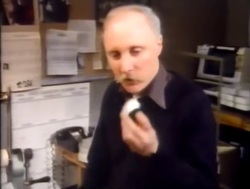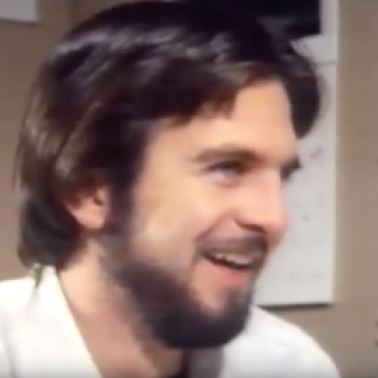Imagine compositing a shot without seeing the result as you put it together. This is how it was for the Optical Compositing Team at ILM (Industrial Light and Magic) in the 1980s. In ‘Return of the Jedi’ the 19th shot in the Space Battle scene (called SB19) was composited by the Optical Compositing Team at ILM. They were often referred to as The Optical Dogs as they were last in a very long line of technicians to work on a shot. SB19 consisted of 63 different space ships and was made up from 170 rolls of film.

SB19 in all its widescreen glory.
These rolls of film were superimposed on top and behind each other using an Optical Printer. The Optical Printer at ILM meant the technicians could take previously shot elements and build up a new shot by exposing them on to a fresh piece of film, rewinding that film and then exposing another element on top.
Visual Effects Supervisor, Ken Ralston and his Visual Effects Editor, Bill Kimberlin produced the shot by first shooting all the ship elements using the Dykstraflex motion control camera. Kimberlin then choreographed the shot by projecting each of the shot ship elements on to a cell (a piece of transparent film) and drawing around the ships at various points to plot out their paths. This helped Kimberlin to line up the ships movements to one another and so make a dynamic and interesting shot.
Kimberlin plots the path of one of the Tie Fighters and inspects the rolls of film.
Once this ‘cell’ version of the shot was signed off a temp composite was created using the optical printer. It was a very rough black and white version of the shot (the mattes from each ship combined) but something the editors could work with for timings. This temp composite showed Kimberlin and Ralston how the shot was starting to look. What’s interesting here is that the ships were choreographed after they were shot.

The temp composite. You can see the Tie Fighters but also lighting stands!

The dope sheet for SB19. Every mark means a change to the shot.
SB19 took John Ellis (the Optical Printer Technician) 10 hours to composite. One mistake at any point would have rendered the shot unusable and the whole process would have to start again. I wonder how many versions he went through?
Ralston and Ellis.
There is in fact an error in the shot. Towards the end of the shot the Tie Fighters in the background are seen on top of the Millennium Falcon which is in the foreground. Ellis, talking about SB19 in the 1985 Horizon documentary ‘How To Film The Impossible’ said – ‘We don’t get them all perfect… most of them we do!’. I guess the error was deemed too small to go back and fix and so it stayed in the film… that is until the special edition of ‘Return of the Jedi’.
So next time you’re watching ‘Return of the Jedi’ and SB19 pops up think of all the hard work that went into it. It’s mind blowing when you think of all the hours spent on it and all the talented people that created it at ILM. What’s also amazing is that ILM continue to do incredible work to this day, even 30 plus years after ‘Return of the Jedi’ was released… and long may their astounding work continue.
- 1985 Horizon documentary ‘How To Film The Impossible’.
- fxphd: The Role of the Optical Printer.
- Industrial Light and Magic: The Art of Special Effects
- Images taken from the 1985 Horizon documentary ‘How To Film The Impossible’.






Pretty sure the final composite image that is shown is from the special editions version . . . The one I lovingly got to re-composite. Was a honor to re-trace their work and correct the 2 tie fighters through the falcon issue in the original. One layer had to have its compositing layer order switched mid comp.
LikeLiked by 1 person
How exciting! That was indeed an honor. How did you comp the version in the special edition? Were you given the original model rushes to do the fix?
LikeLike
Editorial was able to find most of the pieces, but a few of the smaller background ships were not found. Figured out the needed ships and did a flatbed scan of them, these were then lined up and animated in the comp (visually) by comparing against the original comp footage. We also realized the star field was moving backwards and altered that.
LikeLiked by 1 person
Wow, your story is a blog post in itself! It’s very interesting to hear. It’s a part of VFX history. I’m guessing you were at ILM for this shot? Who were you supervised by? Can I ask – how did you come across my post?
LikeLike